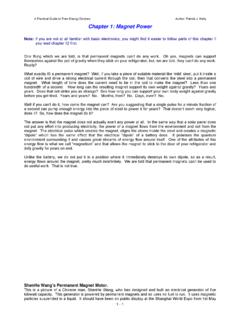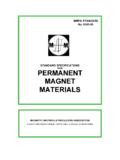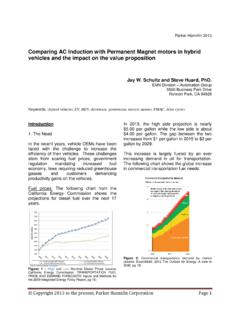Transcription of Methods of Magnetizing Permanent Magnets - Oersted
1 1 Methods of Magnetizing Permanent Magnets EMCW Coil Winding Show 1 October-2 November 2000 Cincinnati , Ohio Joseph J. Stupak Jr. Oersted Technology Corp. 19480 SW Mohave Ct. Tualatin, Oregon USA 97063 Tel (503) 612-9860 fax (503) 692-3518 email Copyright Oersted Technology 2000 Methods of Magnetizing Permanent Magnets 1. Introduction Many people find Magnets to be strange, mysterious things, and I think that physicists are puzzled a good deal more by them then they like to admit. Magnets have been with us a long time, in fact from our earliest history, long before formal science was started, or the mathematics we use to describe it.
2 We all know what Magnets do. Magnets have locations on them, called poles. Poles come in two types, which we call North-seeking poles, or just North poles, and South poles. They always occur in pairs of equal strength, although they may have more than just two poles, of course. Opposite pole types attract, while poles of the same type repel each other. Poles of either type attract iron, steel, and a few other metals such as nickel. These things have been known for thousands of years. Much more recently, that is in the last two hundred years, we have found out that electricity and magnetism are related, and most of the time today we will be talking about ways to use electricity to make certain special materials, called Permanent magnet materials, to be magnetic.
3 When Magnets are first produced, they are usually not magnetic at all, or possibly they are only very weakly magnetic. For the magnet to have the properties we need, it must be magnetized. This can be done at the factory which first made the material, but for a number of reasons it usually is preferable to ship the parts in an unmagnetized state. The Magnets are then either built into useful things like speakers, electric motors, generators, instruments, and such, and then magnetized in place, or else if necessary they are magnetized just before assembly. Some reasons why it is often preferred to magnetize parts at the assembly location are: (1) It may be difficult or impossible, or dangerous for the workers, to assemble the intended product using a magnetized magnet , because of its attraction to steel parts or attraction/repulsion with other Magnets .
4 (2) Permanent Magnets in shipment may affect, damage, or even destroy other items in nearby packages, such as bank records, credit cards, watches, and so on. (3) Large Permanent Magnets may pinch or crush body parts of persons working with the packages, or nearby. (4) Permanent Magnets may affect navigation instruments, especially in aircraft. Laws therefore govern the shipping of Magnets . (5) Magnetized Magnets may pick up magnetically-permeable dirt, which is present almost everywhere. This dirt is often in the form of very tiny, long, pointed needles, which turn vertically to the surface due to action of he magnetic field.
5 They are very difficult to see, and enter the hands of those moving the packages as splinters, which are painful, and difficult to locate and remove. The dirt seems to be derived from magnetite, from rusted iron, and also from iron and steel (perhaps from wear and spall). Magnetic dirt, once on the magnet , is very difficult to clean, as it will just move around a cleaning cloth, or fly back to the attracting surface if separated. The best way to remove it, to my knowledge, is to wrap masking tape around the hand with the sticky side out, and then gently! roll it onto the contaminated surface, being careful to avoid driving sharp particles through the tape and into your hand.
6 2 (6) Manufacturers often need control of the Magnetizing process because of factors other than full magnetization, such as for example the effects of magnetic pattern on cogging , the tendency of a rotor to jump from one rotary position to the next, rather than to turn smoothly, due to magnetic effects. In some cases, this effect is desirable, as for example for magnetic clutches, but often it is harmful, causing inefficiency, noise, and vibration. In addition to complete magnetization, there are some other Magnetizing operations which are often needed. Measurements have to be made to insure that the Magnets , as magnetized, meet the requirements of intended use.
7 Sometimes errors are made in magnetization, handling, or assembly, or for other reasons parts must be demagnetized. Magnets are somewhat variable in strength, from one part to another, and often more from one batch of magnetic material to another. If this variation is too large for the needed purpose, then the Magnets may be partially demagnetized by a small amount, to bring them to closer magnetic tolerances, in a process called " conditioning" In certain magnetic assemblies, conditioning of magnet strength may be done based on the performance of the entire device, rather than that of the magnet alone, thus removing an entire range of variables.
8 This is done, for example, with some magnetic relays. 2. History The earliest Magnets were lodestone Ferric Ferrite, Fe3O4), a sort of natural magnet , related to today s ceramic Magnets . This material was a useful ore for iron, and was mined for that purpose in ancient times. The lodestone (which means travel-stone ) was apparently magnetized from the Earth s magnetic field, as it was deposited. By 1200 AD, compass needles were being made of steel, which were magnetized by being rubbed or touched with lodestones. In 1600 Gilbert recorded three ways to magnetize a steel needle: by touch with a lodestone, by cold drawing in a North-South direction, and by exposure for a very long time to the Earth s field while in a North-South orientation.
9 He also mentions that a magnet when brought to red heat is no longer magnetic, but that it would become magnetic if allowed to cool while pointing North-South. Then, in 1820, Oersted in Denmark discovered that electric current in a wire produced a magnetic field encircling the wire, and soon thereafter Ampere in France was able to deduce the general relationship between electric current in a short element of wire and the magnetic field it produced at any distance and angle. Sturgeon made the first solenoid in 1823, and after a few improvements (such as the invention of electrical insulation, by the American Joseph Henry) it was possible to magnetize Permanent Magnets using electric current.
10 Permanent Magnets made from steel require very little coercive force to magnetize, by comparison to today s magnet materials. On the other hand, these materials are also very easily demagnetized, by shock, other Magnets nearby, or even the effect of the Earth s field, accidentally concentrated by steel objects. In 1932, Alnico was discovered, which is much more stable and also harder to magnetize. The Magnetizing requirement was still not difficult to meet, however, by just using electric current off the lines and a solenoid, or a transformer to boost the current and a few turn of wire. Large C frame magnetizers using thousands of turns for each of two coils could magnetize assemblies on a conveyor belt.





